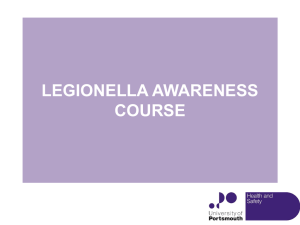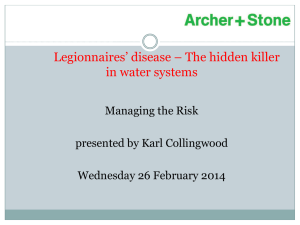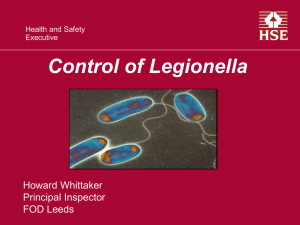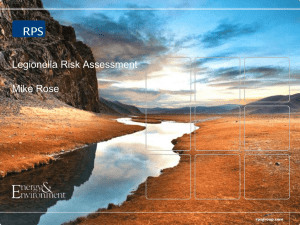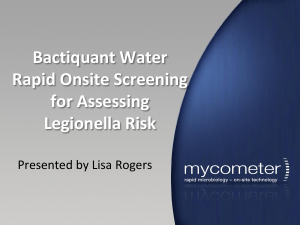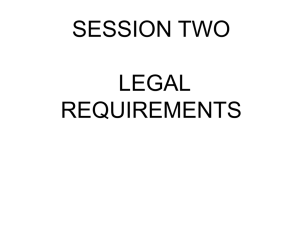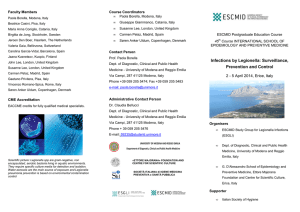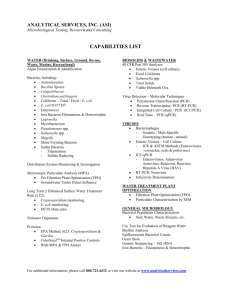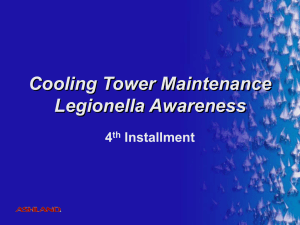ID 18i3 April 2015
advertisement
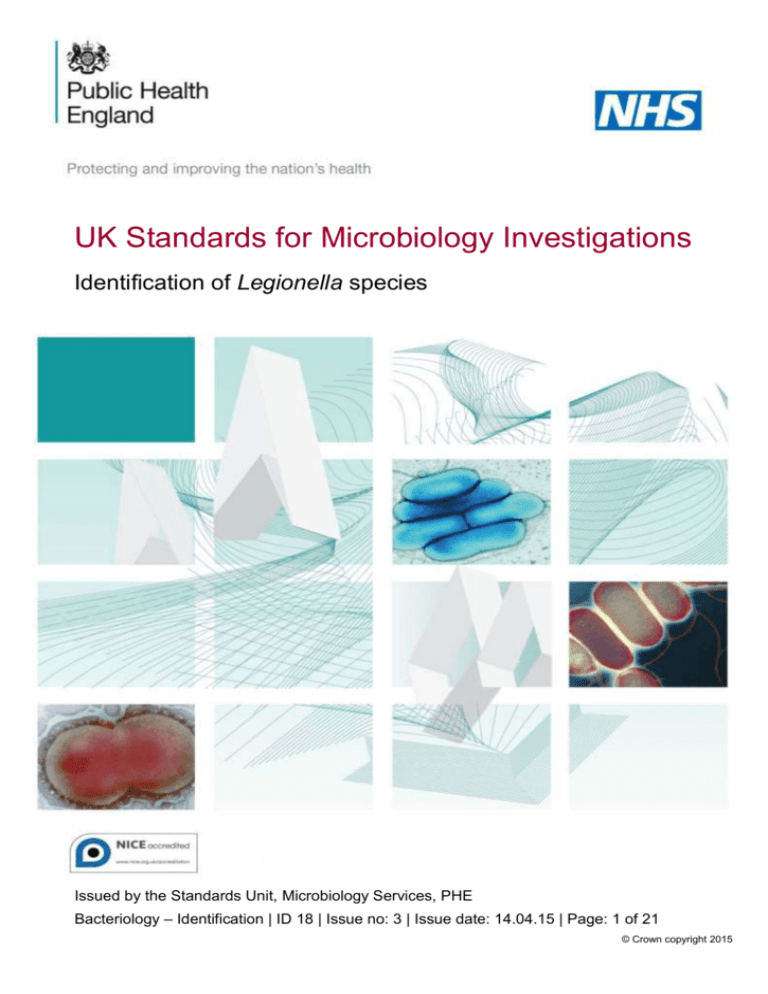
UK Standards for Microbiology Investigations Identification of Legionella species Issued by the Standards Unit, Microbiology Services, PHE Bacteriology – Identification | ID 18 | Issue no: 3 | Issue date: 14.04.15 | Page: 1 of 21 © Crown copyright 2015 Identification of Legionella species Acknowledgments UK Standards for Microbiology Investigations (SMIs) are developed under the auspices of Public Health England (PHE) working in partnership with the National Health Service (NHS), Public Health Wales and with the professional organisations whose logos are displayed below and listed on the website https://www.gov.uk/ukstandards-for-microbiology-investigations-smi-quality-and-consistency-in-clinicallaboratories. SMIs are developed, reviewed and revised by various working groups which are overseen by a steering committee (see https://www.gov.uk/government/groups/standards-for-microbiology-investigationssteering-committee). The contributions of many individuals in clinical, specialist and reference laboratories who have provided information and comments during the development of this document are acknowledged. We are grateful to the Medical Editors for editing the medical content. For further information please contact us at: Standards Unit Microbiology Services Public Health England 61 Colindale Avenue London NW9 5EQ E-mail: standards@phe.gov.uk Website: https://www.gov.uk/uk-standards-for-microbiology-investigations-smi-qualityand-consistency-in-clinical-laboratories PHE Publications gateway number: 2015013 UK Standards for Microbiology Investigations are produced in association with: Logos correct at time of publishing. Bacteriology – Identification | ID 18 | Issue no: 3 | Issue date: 14.04.15 | Page: 2 of 21 UK Standards for Microbiology Investigations | Issued by the Standards Unit, Public Health England Identification of Legionella species Contents ACKNOWLEDGMENTS .......................................................................................................... 2 CONTENTS ............................................................................................................................. 3 AMENDMENT TABLE ............................................................................................................. 4 UK STANDARDS FOR MICROBIOLOGY INVESTIGATIONS: SCOPE AND PURPOSE ....... 6 SCOPE OF DOCUMENT ......................................................................................................... 9 INTRODUCTION ..................................................................................................................... 9 TECHNICAL INFORMATION/LIMITATIONS ......................................................................... 10 1 SAFETY CONSIDERATIONS .................................................................................... 11 2 TARGET ORGANISMS .............................................................................................. 11 3 IDENTIFICATION ....................................................................................................... 11 4 IDENTIFICATION OF LEGIONELLA SPECIES ......................................................... 16 5 REPORTING .............................................................................................................. 17 6 REFERRALS.............................................................................................................. 17 7 NOTIFICATION TO PHE OR EQUIVALENT IN THE DEVOLVED ADMINISTRATIONS .................................................................................................. 18 REFERENCES ...................................................................................................................... 19 Bacteriology – Identification | ID 18 | Issue no: 3 | Issue date: 14.04.15 | Page: 3 of 21 UK Standards for Microbiology Investigations | Issued by the Standards Unit, Public Health England Identification of Legionella species Amendment Table Each SMI method has an individual record of amendments. The current amendments are listed on this page. The amendment history is available from standards@phe.gov.uk. New or revised documents should be controlled within the laboratory in accordance with the local quality management system. Amendment No/Date. 5/14.04.15 Issue no. discarded. 2.2 Insert Issue no. 3 Section(s) involved Amendment Whole document. Hyperlinks updated to gov.uk. Page 2. Updated logos added. The taxonomy of Legionella species has been updated. Introduction. More information has been added to the Characteristics section. The medically important species are mentioned. Section on Principles of Identification has been updated to include the MALDI-TOF. Technical Information/Limitations. Addition of information regarding Agar Media, Lcysteine requirement, Gram stain and serotyping. Target Organisms. The section on the Target organisms has been updated and presented clearly. Updates have been done on 3.2, 3.3 and 3.4 to reflect standards in practice. Identification. Section 3.4.3, 3.4.4 and 3.4.5 has been updated to include Commercial Identification Systems, MALDI-TOF MS and NAATs with references. Subsection 3.5 has been updated to include the Rapid Molecular Methods. Identification Flowchart. Modification of flowchart for identification of Legionella species has been done for easy guidance. Reporting. Subsections 5.3 and 5.5 have been updated to reflect the information required on reporting practice. Bacteriology – Identification | ID 18 | Issue no: 3 | Issue date: 14.04.15 | Page: 4 of 21 UK Standards for Microbiology Investigations | Issued by the Standards Unit, Public Health England Identification of Legionella species Referral. The addresses of the reference laboratories have been updated. References. Some references updated. Bacteriology – Identification | ID 18 | Issue no: 3 | Issue date: 14.04.15 | Page: 5 of 21 UK Standards for Microbiology Investigations | Issued by the Standards Unit, Public Health England Identification of Legionella species UK Standards for Microbiology Investigations: Scope and Purpose Users of SMIs SMIs are primarily intended as a general resource for practising professionals operating in the field of laboratory medicine and infection specialties in the UK SMIs provide clinicians with information about the available test repertoire and the standard of laboratory services they should expect for the investigation of infection in their patients, as well as providing information that aids the electronic ordering of appropriate tests SMIs provide commissioners of healthcare services with the appropriateness and standard of microbiology investigations they should be seeking as part of the clinical and public health care package for their population Background to SMIs SMIs comprise a collection of recommended algorithms and procedures covering all stages of the investigative process in microbiology from the pre-analytical (clinical syndrome) stage to the analytical (laboratory testing) and post analytical (result interpretation and reporting) stages. Syndromic algorithms are supported by more detailed documents containing advice on the investigation of specific diseases and infections. Guidance notes cover the clinical background, differential diagnosis, and appropriate investigation of particular clinical conditions. Quality guidance notes describe laboratory processes which underpin quality, for example assay validation. Standardisation of the diagnostic process through the application of SMIs helps to assure the equivalence of investigation strategies in different laboratories across the UK and is essential for public health surveillance, research and development activities. Equal Partnership Working SMIs are developed in equal partnership with PHE, NHS, Royal College of Pathologists and professional societies. The list of participating societies may be found at https://www.gov.uk/uk-standards-formicrobiology-investigations-smi-quality-and-consistency-in-clinical-laboratories. Inclusion of a logo in an SMI indicates participation of the society in equal partnership and support for the objectives and process of preparing SMIs. Nominees of professional societies are members of the Steering Committee and Working Groups which develop SMIs. The views of nominees cannot be rigorously representative of the members of their nominating organisations nor the corporate views of their organisations. Nominees act as a conduit for two way reporting and dialogue. Representative views are sought through the consultation process. SMIs are developed, reviewed and updated through a wide consultation process. Microbiology is used as a generic term to include the two GMC-recognised specialties of Medical Microbiology (which includes Bacteriology, Mycology and Parasitology) and Medical Virology. Bacteriology – Identification | ID 18 | Issue no: 3 | Issue date: 14.04.15 | Page: 6 of 21 UK Standards for Microbiology Investigations | Issued by the Standards Unit, Public Health England Identification of Legionella species Quality Assurance NICE has accredited the process used by the SMI Working Groups to produce SMIs. The accreditation is applicable to all guidance produced since October 2009. The process for the development of SMIs is certified to ISO 9001:2008. SMIs represent a good standard of practice to which all clinical and public health microbiology laboratories in the UK are expected to work. SMIs are NICE accredited and represent neither minimum standards of practice nor the highest level of complex laboratory investigation possible. In using SMIs, laboratories should take account of local requirements and undertake additional investigations where appropriate. SMIs help laboratories to meet accreditation requirements by promoting high quality practices which are auditable. SMIs also provide a reference point for method development. The performance of SMIs depends on competent staff and appropriate quality reagents and equipment. Laboratories should ensure that all commercial and in-house tests have been validated and shown to be fit for purpose. Laboratories should participate in external quality assessment schemes and undertake relevant internal quality control procedures. Patient and Public Involvement The SMI Working Groups are committed to patient and public involvement in the development of SMIs. By involving the public, health professionals, scientists and voluntary organisations the resulting SMI will be robust and meet the needs of the user. An opportunity is given to members of the public to contribute to consultations through our open access website. Information Governance and Equality PHE is a Caldicott compliant organisation. It seeks to take every possible precaution to prevent unauthorised disclosure of patient details and to ensure that patient-related records are kept under secure conditions. The development of SMIs are subject to PHE Equality objectives https://www.gov.uk/government/organisations/public-health-england/about/equalityand-diversity. The SMI Working Groups are committed to achieving the equality objectives by effective consultation with members of the public, partners, stakeholders and specialist interest groups. Legal Statement Whilst every care has been taken in the preparation of SMIs, PHE and any supporting organisation, shall, to the greatest extent possible under any applicable law, exclude liability for all losses, costs, claims, damages or expenses arising out of or connected with the use of an SMI or any information contained therein. If alterations are made to an SMI, it must be made clear where and by whom such changes have been made. The evidence base and microbial taxonomy for the SMI is as complete as possible at the time of issue. Any omissions and new material will be considered at the next review. These standards can only be superseded by revisions of the standard, legislative action, or by NICE accredited guidance. SMIs are Crown copyright which should be acknowledged where appropriate. Bacteriology – Identification | ID 18 | Issue no: 3 | Issue date: 14.04.15 | Page: 7 of 21 UK Standards for Microbiology Investigations | Issued by the Standards Unit, Public Health England Identification of Legionella species Suggested Citation for this Document Public Health England. (2015). Identification of Legionella species. UK Standards for Microbiology Investigations. ID 18 Issue 3. https://www.gov.uk/uk-standards-formicrobiology-investigations-smi-quality-and-consistency-in-clinical-laboratories Bacteriology – Identification | ID 18 | Issue no: 3 | Issue date: 14.04.15 | Page: 8 of 21 UK Standards for Microbiology Investigations | Issued by the Standards Unit, Public Health England Identification of Legionella species Scope of Document This SMI describes the presumptive identification of Legionella species isolated from clinical specimens to genus level. Full identification of Legionella species is not cost effective in most routine clinical microbiology laboratories and isolates should be sent to the Reference Laboratory. This SMI should be used in conjunction with other SMIs. Introduction Taxonomy The family Legionellaceae currently compromises 52 species and in excess of 70 serogroups1,2. More than 90% of isolates associated with Legionnaires’ disease are Legionella pneumophila, with 84% being L. pneumophila serogroup 1 (sg1), nearly one-half of Legionella species have been associated with human disease3. There are 3 subspecies and 16 serogroups of L. pneumophila, but serogroup 1 accounts for the majority of strains from human infections4. Characteristics The family Legionellaceae consists of faintly staining, Gram negative, pleomorphic rods. They generally appear as coccobacilli in tissue or secretions, but may become filamentous in culture. The organisms are aerobic, nutritionally fastidious and will not grow on blood agar or buffered charcoal yeast extract agar without cysteine (BCYE). The presence of cysteine and soluble iron in the media also helps to support their growth2. Members of the genus are relatively inert biochemically, catalase positive (some may be only weakly catalase positive), oxidase-variable and possess polar flagella. Some species other than L. pneumophila fluoresce blue-white under long-wave UV light (360nm 20nm) whilst others fluoresce dull yellow or brick red5. The medically important Legionella specie commonly isolated in human infections; Legionella pneumophila There are three subspecies of Legionella pneumophila - Legionella pneumophila subspecies fraseri, Legionella pneumophila subspecies pascullei and Legionella pneumophila subspecies pneumophila1,6. Cells are Gram negative, non-acid fast rods, 0.3-0.9µm wide and 2-20µm or more long. They are non-encapsulated, non-spore forming and are aerobic. They are motile by one or more straight or curved polar or lateral flagella; occasional strains are non-motile. They are oxidase – variable and catalase positive and also produce beta-lactamase but are unable to produce urease or reduce nitrates. They are consistently positive for hippurate hydrolysis. They are chemoorganotrophic, using amino acids as carbon and energy sources. Carbohydrates are neither fermented nor oxidized. A brown, diffusible pigment is formed in media containing tyrosine7. The optimal growth temperature is 35-37°C. Growth on solid media is enhanced by increased humidity. Incubation in 2-5% CO2 can enhance growth of some Legionella Bacteriology – Identification | ID 18 | Issue no: 3 | Issue date: 14.04.15 | Page: 9 of 21 UK Standards for Microbiology Investigations | Issued by the Standards Unit, Public Health England Identification of Legionella species specie8. On BCYE agar, colonies are "opal-like", grey-white with a textured, cut-glass appearance. It also requires cysteine and iron to thrive. They do not grow on blood agar or other commonly used primary plate media. They do not exhibit blue-white or red auto-fluorescence. This has been isolated from sputum, blood, serum, bronchoalveolar lavage, lung tissue, human placental cord as well as from air, water, mud, industrial cooling towers, etc. It is the major causative agent of legionellosis6,8. Other Legionella species that have been associated with human diseases have been mentioned in section 2 of this document. Principles of Identification Colonies isolated on Legionella selective agar are identified by colonial morphology, Gram’s stain and by the requirement of L-cysteine for growth. Full molecular identification using for example, MALDI-TOF MS can be used to identify Legionella isolates to species level. Typing and differentiation between strains of Legionella pneumophila can be achieved using a range of molecular techniques eg Real-time Polymerase Chain reaction (PCR), Sequence based typing (SBT), Pulsed Field Gel Electrophoresis (PFGE), Whole Generation sequencing, etc. For more information, see section 3.5 on further identification. All isolates from clinical specimens should be sent to the Reference Laboratory for confirmation and further identification. Technical Information/Limitations L- Cysteine Requirement Laboratories should be aware that some strains of L. oakridgensis lose the requirement for L-cysteine9. Gram stain Legionella stains poorly with gram stain and stains positive with silver or Giemsa stain. Gram stain should be prepared from culture on charcoal yeast extract agar with iron and cysteine7. Serotyping The use of antisera for identifying Legionella species suffer from low sensitivity and specificity; cross-reactivity between serogroups, between the various species of the Legionella genus, and even with other genera has been consistently reported and so under the circumstances, the “gold standard” for diagnosing any form of infection with Legionella specie remains isolation in culture10,11. Antisera for many Legionella species, especially newer species are not available commercially7,8. Agar plate BMPAα is recommended for clinical specimens, although there have been reports of cefamandole being inhibitory to some Legionella species8. Bacteriology – Identification | ID 18 | Issue no: 3 | Issue date: 14.04.15 | Page: 10 of 21 UK Standards for Microbiology Investigations | Issued by the Standards Unit, Public Health England Identification of Legionella species 1 Safety Considerations12-28 Legionella species are in Hazard Group 2 although in some cases the nature of the work with L. pneumophila may dictate full Containment Level 3 conditions. Refer to current guidance on the safe handling of all organisms documented in this SMI. The organism infects primarily by the respiratory route. Laboratory procedures that give rise to infectious aerosols must be conducted in a microbiological safety cabinet. The above guidance should be supplemented with local COSHH and risk assessments. Compliance with postal and transport regulations is essential. 2 Target Organisms Legionella species Commonly Reported to have Caused Human Infections4,6 Legionella pneumophila Other Legionella species Reported to have Caused Human Infections 1,29,30 L. anisa, L. birminghamensis, L. cardiac, L. cherrii, L. cincinnatiensis, L. feeleii, L. gratiana, L. hackeliae, L. jordanis, L. lansingensis, L. longbeachae, L. lytica, L. nagasakiensis, L. oakridgensis, L. quinlivanii, L. sainthelensi, L. santicrucis, L. steelei, L. tucsonensis, L. wadsworthii 3 Identification 3.1 Microscopic Appearance Gram stain (TP 39 - Staining Procedures) Cells are Gram negative poorly/faintly staining thin rods, which may be filamentous in older cultures. Note: Gram stain should be prepared from cysteine containing agar only. 3.2 Primary Isolation Media 1. Buffered-charcoal-yeast extract (BCYE) agar base supplemented with ACES (N-2acetamido-2-aminoethanesulphuronic acid) buffer with L-cysteine incubated for up to 10 days in a moist atmosphere at 35-37°C and 2. Selective agar; Buffered cefamandole, polymyxin, anisomycin, α-ketoglutarate medium (BMPAα) incubated for up to 10 days in a moist atmosphere at 35-37°C. Bacteriology – Identification | ID 18 | Issue no: 3 | Issue date: 14.04.15 | Page: 11 of 21 UK Standards for Microbiology Investigations | Issued by the Standards Unit, Public Health England Identification of Legionella species Note: Incubation in 2-5% CO2 can enhance growth of some Legionella species such as L. sainthelensi and L. oakridgensis8. This low level of CO2 will not affect the growth of L. pneumophila, but CO2 levels higher than 5% may inhibit growth. 3.3 Colonial Appearance This requires the use of a low power binocular microscope with incident light illuminating the agar surface at an acute angle. Legionella colonies appear as convex, circular white colonies having a centre that resembles ground glass. However, it takes a minimum of 36hr incubation before colonies can be seen, even with a low power microscope. A plate viewed at 24hr will provide information of the location, number and morphology of contaminants. This will assist in eliminating ‘suspect’ colonies which might be further investigated if the plates are not read until 3 days. Colony edges are entire and tend to have speckled green or pinkish purple iridescent edges. The colour of the colonies may be a variety of shades of purple or green or a range of colours depending on the thickness of the agar plate and the age of the culture (colonies become grey with age). 3.4 Test Procedures 3.4.1 Biochemical tests Catalase Test (TP 8 – Catalase Test) - Optional All Legionella species are positive. Subculture to Legionella selective and non-selective agar. Legionella species will grow on Legionella agar base (BCYE) supplemented with ACES buffer, L-cysteine. Suspect Legionella species will not grow on the same medium from which L-cysteine has been omitted. Growth on both plates indicates that the organism is not Legionella species (except that some strains of L. oakridgensis lose the requirement for L-cysteine). See Technical Information. Inoculate each agar plate and for the isolation of individual colonies, spread inoculum with a sterile loop (see Q 5 - Inoculation of Culture Media for Bacteriology). Colonies may be examined under long-wave UV light (360 nm 20nm) to reveal yellow pigment on BCYE or auto-fluorescence of Legionella colonies. Following subculture, Gram’s stain and catalase, cultures at this stage should be regarded as presumptive until confirmed by the Reference Laboratory. 3.4.2 Serotyping Techniques include a latex agglutination screening test, an indirect fluorescent antibody test (IFA) test and enzyme immunoassays (EIA)11. Cross-reactions with antibodies to Campylobacter species, Pseudomonas aeruginosa, Haemophilus species and other bacteria can occur and has been reported31. 3.4.3 Commercial Identification Systems Laboratories should follow manufacturer’s instructions and rapid tests and kits should be validated and be shown to be fit for purpose prior to use. Use a commercial system (latex or DFA) on a ‘presumptive’ isolate to get a basic identification, this should be supported by a Reference Laboratory report. Bacteriology – Identification | ID 18 | Issue no: 3 | Issue date: 14.04.15 | Page: 12 of 21 UK Standards for Microbiology Investigations | Issued by the Standards Unit, Public Health England Identification of Legionella species 3.4.4 Matrix Assisted Laser Desorption/Ionisation - Time of Flight Mass Spectrometry (MALDI-TOF MS) Matrix assisted laser desorption ionization–time-of-flight mass spectrometry (MALDITOF MS), which can be used to analyse the protein composition of a bacterial cell, has emerged as a new technology for species identification. This has been shown to be a rapid and powerful tool because of its reproducibility, speed and sensitivity of analysis. The advantage of MALDI-TOF as compared with other identification methods is that the results of the analysis are available within a few hours rather than several days. The speed and the simplicity of sample preparation and result acquisition associated with minimal consumable costs make this method well suited for routine and high-throughput use32. This has been used successfully in the rapid and reliable identification of Legionella species33. It allows performing a full analysis from a single colony in only few minutes, thus providing an inexpensive and rapid screening of a large number of colonies within a short time. The level of accuracy is strongly dependent upon the number of species specific spectra populating the database and so further expansion of the current database will be helpful. However, identification and classification of strains (particularly L. pneumophila) into different serogroups are still not possible using this technology34. 3.4.5 Nucleic Acid Amplification Tests (NAATs) Real-time Polymerase Chain reaction is also called quantitative polymerase chain reaction (qPCR). PCR is usually considered to be a good method for bacterial detection as it is simple, rapid, sensitive and specific. The basis for PCR is the detection of infectious agents and the discrimination of non-pathogenic from pathogenic strains by virtue of specific genes. However, it does have limitations. Although the 16S rRNA gene is generally targeted for the design of species-specific PCR primers for identification, designing primers is difficult when the sequences of the homologous genes have high similarity. PCR has been used for the investigation of Legionella from respiratory secretions, urine and serum4,11,35. PCR has a number of advantages over other diagnostic methods being considerably faster and more sensitive with some studies reporting PCR as more sensitive than culture11. PCR results can be available in about 4 hours from receipt of sample and easier to interpret than culture which takes longer (about 8 days). Multiplex PCR has also been developed and used to simultaneously detect and discriminate Legionella species, Legionella pneumophila, and Legionella pneumophila serogroup 1. This can be used especially in outbreaks situations or for surveillance purposes. It has an added advantage in that it does not require an isolate especially in cases where antibiotics may have been administered that may render the Legionella non-viable but can allow for the potential to detect any remaining nucleic acid present3. Use of PCR tests along with other diagnostic methods described, may lead to a more effective public health response and appropriate treatment of patients. 3.5 Further Identification Bacteriology – Identification | ID 18 | Issue no: 3 | Issue date: 14.04.15 | Page: 13 of 21 UK Standards for Microbiology Investigations | Issued by the Standards Unit, Public Health England Identification of Legionella species Rapid Molecular methods A variety of rapid molecular typing methods have been developed for isolates from clinical samples; these include molecular techniques such as Pulsed Field Gel Electrophoresis (PFGE), Multilocus Sequence Typing (MLST) and Whole Genome Sequencing (WGS). All of these approaches enable subtyping of unrelated strains, but do so with different accuracy, discriminatory power, and reproducibility. Molecular methods have had an enormous impact on the taxonomy of Legionella. Analysis of gene sequences has increased understanding of the phylogenetic relationships of Legionella and related organisms; and has resulted in the recognition of numerous new species. Molecular techniques have made identification of many species more rapid and precise than is possible with phenotypic techniques. However, some of these methods remain accessible to reference laboratories only and are difficult to implement for routine bacterial identification in clinical laboratories. Sequence based Typing A new molecular technique, Sequence Based Typing (SBT), is used by CDC and the European Working Group for Legionella Infections (EWGLI) for subtyping L. pneumophila serogroup 1. Other Legionella species have been identified using this technique. EWGLI has proposed the use of SBT as the standard method for strain identification for travel related outbreaks in the European Union. This standard EWGLI SBT scheme has been extended recently to include the neuA allele, and it is anticipated that the scheme will not change again. An internet-available database (http://www.ewgli.org) allows fast retrieval of known, deposited DNA sequences of Legionella pneumophila. The website also proves detailed instructions regarding the submission of putative novel alleles, ie, submission of consensus sequences together with sequencing results (chromatogram files) from both forward and reverse reactions, to the database curators36,37. A limitation of using sequencing, however, is that it not only requires a considerable amount of time and work but is also coupled with relatively high costs. Pulsed Field Gel Electrophoresis (PFGE) PFGE detects genetic variation between strains using rare-cutting restriction endonucleases, followed by separation of the resulting large genomic fragments on an agarose gel. PFGE is known to be highly discriminatory and a frequently used technique for outbreak investigations and has gained broad application in characterizing epidemiologically related isolates. However, the stability of PFGE may be insufficient for reliable application in long-term epidemiological studies. However, due to its time-consuming nature (30hr or longer to perform) and its requirement for special equipment, PFGE is not used widely outside the reference laboratories 38,39. This technique is the most commonly used to identify and subtype strains of L. pneumophila using AscI as a restriction enzyme. PFGE with AscI digestion has the ability to type all L. pneumophila strains and a higher discriminatory power as well as good reproducibility40. Whole Genome Sequencing (WGS) This is also known as “full genome sequencing, complete genome sequencing, or entire genome sequencing”. It is a laboratory process that determines the complete DNA sequence of an organism's genome at a single time. There are several highthroughput techniques that are available and used to sequence an entire genome Bacteriology – Identification | ID 18 | Issue no: 3 | Issue date: 14.04.15 | Page: 14 of 21 UK Standards for Microbiology Investigations | Issued by the Standards Unit, Public Health England Identification of Legionella species such as pyrosequencing, nanopore technology, IIIumina sequencing, Ion Torrent sequencing, etc. This sequencing method holds great promise for rapid, accurate, and comprehensive identification of bacterial transmission pathways in hospital and community settings, with concomitant reductions in infections, morbidity, and costs. This has been used to differentiate outbreak from non-outbreak isolates during an outbreak of Legionnaires’ disease. The main constraint is the limited number of published genomes for comparison and thus further research work will need to be done to provide larger genomic databases of L. pneumophila from both clinical and environmental sources41. 3.6 Storage and Referral Save pure isolate on either BCYE medium or as a dense suspension in sterile water or Page’s saline for referral to the Reference Laboratory. Bacteriology – Identification | ID 18 | Issue no: 3 | Issue date: 14.04.15 | Page: 15 of 21 UK Standards for Microbiology Investigations | Issued by the Standards Unit, Public Health England Identification of Legionella species 4 Identification of Legionella Species Clinical specimens Primary isolation plate Buffered charcoal yeast extract (BCYE) agar base supplemented with ACES buffer with Lcysteine incubated at 35-37°C in moist air BMPAa Agar incubated at 35-37°C in moist air Ground glass colony with green or purple iridescent entire edge on after a minimum of 36hr incubation; Fluorescence of colonies under UV light Subculture each colonial type on: BCYE with ACES buffer and L-cysteine BCYE with ACES buffer and no L-cysteine Growth on BCYE agar with ACES buffer, L-cysteine and BMPAa No growth on BCYE without L-cysteine Growth on BCYE agar with ACES buffer without L-cysteine Gram Stain on pure culture Gram negative rods (may be filamentous) Disregard organisms with other Gram stain reactions Note: Gram stain from cysteine containing medium only Not Legionella species Discard Note: some strains of L. oakridgensis lose the requirement for L-cysteine Presumptive Legionella species Further identification if clinically indicated, commercial identification kit or IFAT or DFAT or send to the Reference Laboratory. If required save pure isolate on a Legionella agar (with ACES buffer and L-cysteine) slope or make a dense suspension in sterile water (not saline) The flowchart is for guidance only. Bacteriology – Identification | ID 18 | Issue no: 3 | Issue date: 14.04.15 | Page: 16 of 21 UK Standards for Microbiology Investigations | Issued by the Standards Unit, Public Health England Identification of Legionella species 5 5.1 Reporting Presumptive Identification If appropriate growth characteristics, colonial appearance, catalase and Gram’s stain are demonstrated. 5.2 Confirmation of Identification Further biomedical tests and/or molecular methods and/or Reference laboratory report. 5.3 Medical Microbiologist Inform the medical microbiologist of any presumptive Legionella species. The medical microbiologist should be informed of all confirmed Legionella isolates. Follow local protocols for reporting to clinician. 5.4 CCDC Refer to local Memorandum of Understanding. 5.5 Public Health England42 Refer to current guidelines on CIDSC and COSURV reporting. As Legionnaires’ disease is a notifiable disease in the UK, for public health management of cases, contacts and outbreaks, all suspected cases should be notified immediately to the local Public Health England Centres. All clinically significant isolates should be notified by the diagnostic laboratories to ensure urgent initiation of proper procedures and all such isolates should be referred to the national reference laboratory for confirmation. 5.6 Infection Prevention and Control Team Inform the infection prevention and control team of new and presumptive isolates of Legionella species. 6 Referrals 6.1 Reference Laboratory Contact appropriate devolved national reference laboratory for information on the tests available, turnaround times, transport procedure and any other requirements for sample submission: Respiratory and Vaccine Preventable Bacteria Reference Unit Public Health England 61 Colindale Avenue London NW9 5EQ https://www.gov.uk/rvpbru-reference-and-diagnostic-services Tel: 020 8327 7331 or 6906 or 7222 Contact PHE’s main switchboard: Tel. +44 (0) 20 8200 4400 Bacteriology – Identification | ID 18 | Issue no: 3 | Issue date: 14.04.15 | Page: 17 of 21 UK Standards for Microbiology Investigations | Issued by the Standards Unit, Public Health England Identification of Legionella species England and Wales https://www.gov.uk/specialist-and-reference-microbiology-laboratory-tests-andservices 7 Notification to PHE42,43 or Equivalent in the Devolved Administrations44-47 The Health Protection (Notification) regulations 2010 require diagnostic laboratories to notify Public Health England (PHE) when they identify the causative agents that are listed in Schedule 2 of the Regulations. Notifications must be provided in writing, on paper or electronically, within seven days. Urgent cases should be notified orally and as soon as possible, recommended within 24 hours. These should be followed up by written notification within seven days. For the purposes of the Notification Regulations, the recipient of laboratory notifications is the local PHE Health Protection Team. If a case has already been notified by a registered medical practitioner, the diagnostic laboratory is still required to notify the case if they identify any evidence of an infection caused by a notifiable causative agent. Notification under the Health Protection (Notification) Regulations 2010 does not replace voluntary reporting to PHE. The vast majority of NHS laboratories voluntarily report a wide range of laboratory diagnoses of causative agents to PHE and many PHE Health protection Teams have agreements with local laboratories for urgent reporting of some infections. This should continue. Note: The Health Protection Legislation Guidance (2010) includes reporting of Human Immunodeficiency Virus (HIV) & Sexually Transmitted Infections (STIs), Healthcare Associated Infections (HCAIs) and Creutzfeldt–Jakob disease (CJD) under ‘Notification Duties of Registered Medical Practitioners’: it is not noted under ‘Notification Duties of Diagnostic Laboratories’. https://www.gov.uk/government/organisations/public-health-england/about/ourgovernance#health-protection-regulations-2010 Other arrangements exist in Scotland44,45, Wales46 and Northern Ireland47. Bacteriology – Identification | ID 18 | Issue no: 3 | Issue date: 14.04.15 | Page: 18 of 21 UK Standards for Microbiology Investigations | Issued by the Standards Unit, Public Health England Identification of Legionella species References 1. Euzeby,JP. List of Prokaryotic names with standing in nomenclature - Genus Legionella. 2013. 2. Bangsborg JM. Antigenic and genetic characterization of Legionella proteins: contributions to taxonomy, diagnosis and pathogenesis. APMIS Suppl 1997;70:1-53. 3. Benitez AJ, Winchell JM. Clinical Application of a Multiplex Real-Time PCR Assay for Simultaneous Detection of Legionella Species, Legionella pneumophila, and Legionella pneumophila Serogroup 1. J Clin Microbiol 2013;51:348-51. 4. Stout JE, Yu VL. Legionellosis. N Engl J Med 1997;337:682-7. 5. Vickers RM, Yu VL. Clinical laboratory differentiation of Legionellaceae family members with pigment production and fluorescence on media supplemented with aromatic substrates. J Clin Microbiol 1984;19:583-7. 6. Brenner DJ, Steigerwalt AG, Epple P, Bibb WF, McKinney RM, Starnes RW, et al. Legionella pneumophila serogroup Lansing 3 isolated from a patient with fatal pneumonia, and descriptions of L. pneumophila subsp. pneumophila subsp. nov., L. pneumophila subsp. fraseri subsp. nov., and L. pneumophila subsp. pascullei subsp. nov. J Clin Microbiol 1988;26:1695-703. 7. MacFaddin JF. Gram- Negative Bacteria. Biochemical Tests for Identification of Medical Bacteria. 3rd ed. Philadelphia: Lippincott Williams and Wilkins; 2000. p. 624-731. 8. Edelstein P. Legionella. In: Carroll K, Funke G, Jorgensen JH, Landry ML, Warnock DW, editors. Manual of Clinical Microbiology Volume 1. 10th ed. Washington, DC: ASM Press; 2011. p. 770-85. 9. Orrison LH, Cherry WB, Tyndall RL, Fliermans CB, Gough SB, Lambert MA, et al. Legionella oakridgensis: unusual new species isolated from cooling tower water. Appl Environ Microbiol 1983;45:536-45. 10. Roig J, Casal J. Is serological diagnosis of Legionnaires' disease a reliable method? Diagn Microbiol Infect Dis 2002;43:171-2. 11. Lindsay DS, Abraham WH, Findlay W, Christie P, Johnston F, Edwards GF. Laboratory diagnosis of legionnaires' disease due to Legionella pneumophila serogroup 1: comparison of phenotypic and genotypic methods. J Med Microbiol 2004;53:183-7. 12. European Parliament. UK Standards for Microbiology Investigations (SMIs) use the term "CE marked leak proof container" to describe containers bearing the CE marking used for the collection and transport of clinical specimens. The requirements for specimen containers are given in the EU in vitro Diagnostic Medical Devices Directive (98/79/EC Annex 1 B 2.1) which states: "The design must allow easy handling and, where necessary, reduce as far as possible contamination of, and leakage from, the device during use and, in the case of specimen receptacles, the risk of contamination of the specimen. The manufacturing processes must be appropriate for these purposes". 13. Official Journal of the European Communities. Directive 98/79/EC of the European Parliament and of the Council of 27 October 1998 on in vitro diagnostic medical devices. 7-12-1998. p. 1-37. 14. Health and Safety Executive. Safe use of pneumatic air tube transport systems for pathology specimens. 9/99. 15. Department for transport. Transport of Infectious Substances, 2011 Revision 5. 2011. 16. World Health Organization. Guidance on regulations for the Transport of Infectious Substances 2013-2014. 2012. Bacteriology – Identification | ID 18 | Issue no: 3 | Issue date: 14.04.15 | Page: 19 of 21 UK Standards for Microbiology Investigations | Issued by the Standards Unit, Public Health England Identification of Legionella species 17. Home Office. Anti-terrorism, Crime and Security Act. 2001 (as amended). 18. Advisory Committee on Dangerous Pathogens. The Approved List of Biological Agents. Health and Safety Executive. 2013. p. 1-32 19. Advisory Committee on Dangerous Pathogens. Infections at work: Controlling the risks. Her Majesty's Stationery Office. 2003. 20. Advisory Committee on Dangerous Pathogens. Biological agents: Managing the risks in laboratories and healthcare premises. Health and Safety Executive. 2005. 21. Advisory Committee on Dangerous Pathogens. Biological Agents: Managing the Risks in Laboratories and Healthcare Premises. Appendix 1.2 Transport of Infectious Substances Revision. Health and Safety Executive. 2008. 22. Centers for Disease Control and Prevention. Guidelines for Safe Work Practices in Human and Animal Medical Diagnostic Laboratories. MMWR Surveill Summ 2012;61:1-102. 23. Health and Safety Executive. Control of Substances Hazardous to Health Regulations. The Control of Substances Hazardous to Health Regulations 2002. 5th ed. HSE Books; 2002. 24. Health and Safety Executive. Five Steps to Risk Assessment: A Step by Step Guide to a Safer and Healthier Workplace. HSE Books. 2002. 25. Health and Safety Executive. A Guide to Risk Assessment Requirements: Common Provisions in Health and Safety Law. HSE Books. 2002. 26. Health Services Advisory Committee. Safe Working and the Prevention of Infection in Clinical Laboratories and Similar Facilities. HSE Books. 2003. 27. British Standards Institution (BSI). BS EN12469 - Biotechnology - performance criteria for microbiological safety cabinets. 2000. 28. British Standards Institution (BSI). BS 5726:2005 - Microbiological safety cabinets. Information to be supplied by the purchaser and to the vendor and to the installer, and siting and use of cabinets. Recommendations and guidance. 24-3-2005. p. 1-14 29. Tang PW, Toma S, MacMillan LG. Legionella oakridgensis: laboratory diagnosis of a human infection. J Clin Microbiol 1985;21:462-3. 30. Vinh DC, Garceau R, Martinez G, Wiebe D, Burdz T, Reimer A, et al. Legionella jordanis lower respiratory tract infection: case report and review. J Clin Microbiol 2007;45:2321-3. 31. Maiwald M, Helbig JH, Luck PC. Laboratory methods for the diagnosis of Legionella infections. Journal of Microbiological Methods 1998;33:59-79. 32. Barbuddhe SB, Maier T, Schwarz G, Kostrzewa M, Hof H, Domann E, et al. Rapid identification and typing of listeria species by matrix-assisted laser desorption ionization-time of flight mass spectrometry. Appl Environ Microbiol 2008;74:5402-7. 33. Gaia V, Casati S, Tonolla M. Rapid identification of Legionella spp. by MALDI-TOF MS based protein mass fingerprinting. Syst Appl Microbiol 2011;34:40-4. 34. Clark AE, Kaleta EJ, Arora A, Wolk DM. Matrix-assisted laser desorption ionization-time of flight mass spectrometry: a fundamental shift in the routine practice of clinical microbiology. Clin Microbiol Rev 2013;26:547-603. 35. Rantakokko-Jalava K, Jalava J. Development of conventional and real-time PCR assays for detection of Legionella DNA in respiratory specimens. J Clin Microbiol 2001;39:2904-10. Bacteriology – Identification | ID 18 | Issue no: 3 | Issue date: 14.04.15 | Page: 20 of 21 UK Standards for Microbiology Investigations | Issued by the Standards Unit, Public Health England Identification of Legionella species 36. Gaia V, Fry NK, Afshar B, Luck PC, Meugnier H, Etienne J, et al. Consensus sequence-based scheme for epidemiological typing of clinical and environmental isolates of Legionella pneumophila. J Clin Microbiol 2005;43:2047-52. 37. Ratzow S, Gaia V, Helbig JH, Fry NK, Luck PC. Addition of neuA, the gene encoding Nacylneuraminate cytidylyl transferase, increases the discriminatory ability of the consensus sequence-based scheme for typing Legionella pneumophila serogroup 1 strains. J Clin Microbiol 2007;45:1965-8. 38. Liu D. Identification, subtyping and virulence determination of Listeria monocytogenes, an important foodborne pathogen. J Med Microbiol 2006;55:645-59. 39. Brosch R, Brett M, Catimel B, Luchansky JB, Ojeniyi B, Rocourt J. Genomic fingerprinting of 80 strains from the WHO multicenter international typing study of listeria monocytogenes via pulsedfield gel electrophoresis (PFGE). Int J Food Microbiol 1996;32:343-55. 40. Zhou H, Ren H, Zhu B, Kan B, Xu J, Shao Z. Optimization of Pulsed-Field Gel Electrophoresis for Legionella pneumophila Subtyping. Appl Environ Microbiol 2010;76:1334-40. 41. Reuter S, Harrison TG, Koser CU, Ellington MJ, Smith GP, Parkhill J, et al. A pilot study of rapid whole-genome sequencing for the investigation of a Legionella outbreak. BMJ Open 2013;3. 42. Public Health England. Laboratory Reporting to Public Health England: A Guide for Diagnostic Laboratories. 2013. p. 1-37. 43. Department of Health. Health Protection Legislation (England) Guidance. 2010. p. 1-112. 44. Scottish Government. Public Health (Scotland) Act. 2008 (as amended). 45. Scottish Government. Public Health etc. (Scotland) Act 2008. Implementation of Part 2: Notifiable Diseases, Organisms and Health Risk States. 2009. 46. The Welsh Assembly Government. Health Protection Legislation (Wales) Guidance. 2010. 47. Home Office. Public Health Act (Northern Ireland) 1967 Chapter 36. 1967 (as amended). Bacteriology – Identification | ID 18 | Issue no: 3 | Issue date: 14.04.15 | Page: 21 of 21 UK Standards for Microbiology Investigations | Issued by the Standards Unit, Public Health England
